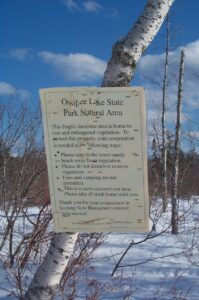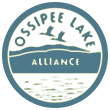From the Archives: A Public Beach in a Natural Area
Part Two: Ossipee Makes its Case for a Beach
Ossipee has always wanted a town beach on its namesake lake. But when money was plentiful, shorefront property wasn’t available, and vice versa. Small wonder that State Representative Harry Merrow’s November 2004 announcement of a beach deal with DRED was cheered by town officials and residents alike.
Not so conservationists and lake organizations, which had been lobbying DRED for years to protect the Natural Area property from ongoing destruction. One organization, Green Mountain Conservation Group, knew the property well, having convinced DRED’s former commissioner, George Bald, to deny a previous Ossipee proposal for a town beach on the property.
In his rejection of that proposal, Bald wrote that a beach would be an “incompatible use” of the Natural Area, adding that the site “deserved to be protected.”
That was in 1999. Five year later, Bald was out, hotel executive Sean O’Kane was in, and another Ossipee beach proposal was on the table. Green Mountain’s Executive Director, Blair Folts, realized the fight to protect the Natural Area from development would have to be waged all over again.
The Experts
By January, 2005, planning for a beach was in full swing at Ossipee Town Hall, with Select Board members working on warrant articles for a vote at the March 9 Town Meeting.
At DRED, meanwhile, the beach idea was making the rounds with the agency’s decision-makers. One of them was Allison McLean, a 15-year DRED veteran who had worked her way up to become Director of Parks and Recreation in October, 2004. A few weeks later, the beach proposal landed on her desk.
Lionel Chute was another department head. Chute held advanced degrees in forestry and ran DRED’s Natural Heritage Bureau, whose staff had been unsuccessfully raising alarms about the Natural Area site for years. Also on the evaluation team was State Archeologist Dr. Richard Boisvert, who headed the agency’s Division of Historical Resources.

A collage of some of the pictures reviewed by state and local officials after repeated pleas from state biologists to restrict recreation at the Natural Area. Alliance Photos
Merrow’s pitch for the project was straight forward. In a newspaper interview he summed up the Natural Area situation as: People are urinating in the water and defecating in the bushes and there are problems with trash.
But, “with properly run facilities at a town beach…at least that section of the beach would be kept in better shape than it is.”
Parks and Recreation Director McLean liked Merrow’s thinking and told a reporter that “Anything’s got to be better than what’s currently going on.”
“Now there is no control, no management [and] people are doing whatever they want,” she said, apparently forgetting that her agency was responsible for managing the property.
While McLean pressed the proposal’s accelerator, Chute and Boisvert pumped the brakes. Chute’s biologists worried that bringing in more people would destroy the remaining rare plants, while Boisvert’s archeologists fretted that the site’s documented historical artifacts would be plundered if the site were made easier to access.
In a joint letter, Chute and Boisvert advised Ossipee that it would have to conduct two studies—an environmental impact study and an archeological study. The studies would be expensive, they said, and either one might produce a finding that doomed the beach proposal, meaning the money would be a sunk cost to the town.
That same week, the Carroll County Independent reported that even if Ossipee could meet the state’s technical and regulatory requirements for a beach, the facility could not be limited to town residents. It would have to be a state public beach funded and managed by the Town of Ossipee.
Town Meeting
Harry Merrow made his case at Town Meeting in March 2005. A $1 per year lease with DRED would give Ossipee 600 feet of shoreline and land access from Route 25. The town would construct a parking lot off the highway and build a boardwalk to the lake over the wetlands. Swim lines would keep boaters away from bathers, and portable toilets would be rented annually.
Merrow emphasized the low cost to the town. He said Ossipee’s Highway Department would build the parking lot and access road, and volunteers would fund and build the boardwalk, much as they had done at near-by Constitution Park.
He downplayed the possibility that the required impact studies might scuttle the project, and said it was fine if non-residents used the beach because their entrance fees would help the town cover operating costs.
“I would expect the beach to be self-funded,” he said.
Town residents spoke mainly in favor, while non-resident taxpayers, conservationists and lake organizations largely objected.
Bob McDonald of Long Sands Association said he supported Ossipee having a beach on the lake, but said the Natural Area plan was “too uncertain at this point for people to support it with a vote.” Blair Folts of Green Mountain Conservation Group pointed to the rare plant species and offered to work with the town to find a different beach site on the lake.
Despite the opposition and financial uncertainties, town voters approved the beach proposal by a wide margin, earmarking $20,000 for construction costs provided that the lease with DRED was no more than $100 annually.
Escalating Uncertainties
In Concord, meanwhile, DRED did not share Merrow’s rosy financial picture. The agency had warned town officials that the required impact studies could be expensive for the town, and now the bill was coming due.
As a State Representative as well as an Ossipee Selectman, Merrow had a formidable voice. He argued that the agency should pay for the studies because the state owned the land. DRED countered that the beach was Ossipee’s idea so the town should pay. DRED prevailed on the point.
There was more. In July, the Select Board met with Edna Feighner, an archeologist with Dick Boisvert’s group. Emptying a bag of dusty stone chips on a table in Town Hall, she told the board the chips were evidence that the Natural Area was occupied more than 10,000 years ago—long before the Abenakis are known to have settled there.

One of the state’s original signs at the site. The number of staples suggests how often they were ripped down and replaced. Alliance Photo
The chips meant that an archeological dig would be needed to determine the Natural Area’s cultural value. A dig could take months, she said, and the more they found, the longer the process and the greater the cost.
“I have no idea how much it might cost,” she told the Select Board. “But it’s up to the Town of Ossipee to foot the bill.”
July also brought a letter from Natural Heritage Bureau Administrator Lionel Chute. Before the archeology study could begin, he wrote, the site’s rare plants and plant communities would have to be mapped to protect them from the archeological dig. The cost of the maps would be in addition to the required environmental impact studies.
What’s more, Chute wrote, since the beach could potentially attract large crowds, Ossipee would be expected to develop “a comprehensive strategy” and provide “staff enforcement” to keep beachgoers out of the rest of the Natural Area property.
Ominous signs also emanated from Parks and Recreation, where Allison McLean’s happy talk about the beach had cooled after Merrow tried to push the project’s costs onto her department.
In a newspaper interview, she conceded for the first time that the beach might place rare plants at risk, adding that only the required impact studies would tell the tale.
“State agencies are willing to work with the town if it goes through with the extensive studies,” she said through a spokesperson in what may have been an oblique suggestion that Ossipee consider withdrawing from the project if it wasn’t willing to pay the costs.
Then she dropped a bombshell. Elaborating on what Chute had alluded to the previous week, she said that if the project went forward, the town would need more than a strategy to keep people inside the “beach bubble.” DRED expected the town to manage the entire 400-acre Natural Area property.
Next: Proponents and opponents dig in, and the discussion turns heated.

Very interesting article that explains a lot of issues a lot of people didn’t know. Thanks for sharing
Several years ago,
while a member of the Ossipee Conservation Commission,
I had a few discussions with a then member of the Select Board regarding the Town Beach proposal issues.
In the town, there was a serious lack of concerns for the cited environmental issues surrounding both the Ossipee Lake Natural Area, as well as another potential site for a town beach. It is unfortunate that in the years past, the town did not have the foresight to acquire the then available land for a developed town beach.
With proper management of the OLNA, with a joint effort of all concerned parties, the “stakeholders”: State Agencies, the Town of Ossipee, Various Lake Associations, and local Conservation Groups, the continued use of the designated areas of the beach front and adjacent waters, will provide some access to local residents and visitors, to our lake.
However, many town residents who are not boaters cannot access this Lakefront area.
Perhaps with some longterm planning both financially and logistically, the town will, in the future, be able to acquire property on the shores of our Lake or Bays for a viable town beach.